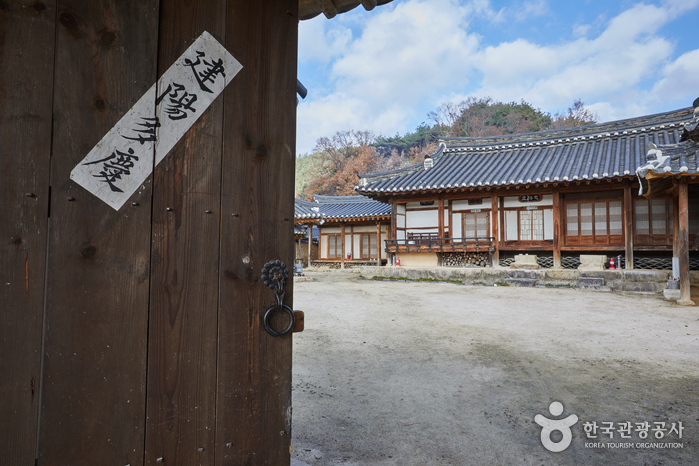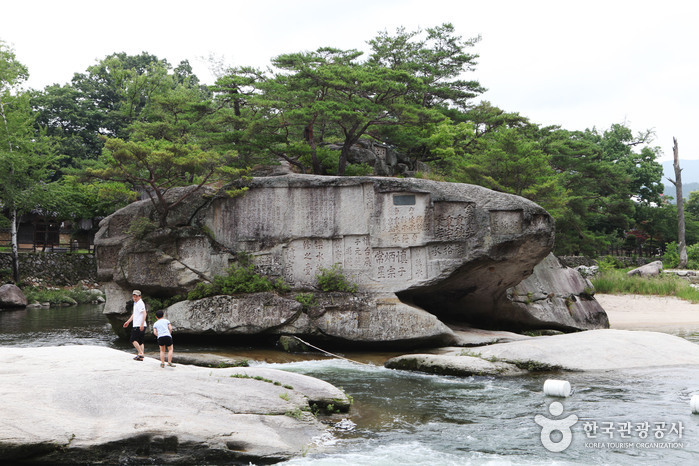Jungon Head House
18.7 Km 803 2021-04-09
13, Gangdong 1-gil, Wicheon-myeon, Geochang-gun, Gyeongsangnam-do
+82-10-2518-4727
Located in Geochang County in Gyeongsangnam-do Province, the Head House of Mr. Jeong On shows a peculiar style of ancient Korean architecture. Since the house is located in a basin surrounded by high mountains, it was built in overlapping style as the typical architectural style in the northern region in order to endure the cold. In addition, the "eyebrow" roof was added as protection from the frequent rain. The house is mainly visited by families on weekends and research organizations on weekdays. Visitors can enjoy various healing and cultural activities in the trekking course of Mt. Geumwonsan and the Suseungdae Amusement Park, which are 1km away. The Anchae is used by the owner family, and the Sarangchae, Jungmunchae, and Daemunchae are used as guest rooms. Groups can rent the entire Sarangchae building.
Dals Garden [Korea Quality] / 달의 정원 [한국관광 품질인증]
18.7 Km 393 2020-09-03
13-31, Chiin 1-gil, Hapcheon-gun, Gyeongsangnam-do
055-934-0107
The ‘Dals Garden’ is a modern facility grafted on a traditional Korean style house. The old but graceful walls with the garden beyond them welcome the guests first. Entering the house, various flower plants and a wide grass garden add to the excitement of travelers. The Toenmaru (a narrow wooden porch running along the outside of the room), pillars and tiles of the neat and well-constructed Korean style house, shine as if they are wiped with oil every day. The peak of Mt. Gayasan beyond the house looks like a picture at a glance. The Moon Garden has 10 rooms in total. Among them, 2 Special Rooms are a little wider than ordinary rooms and equipped with a sink. Though cooking in the room is not allowed, simple food and beverage can be consumed if they are cleaned well afterwards. The room with a single bed is good for a solo traveler or a foreigner who is not accustomed to sleeping in an Ondol room. It takes only 3 minutes to go to Haeinsa Intercity Bus Stop. It is required, however, to pay the admission fee to Haeinsa Temple and the parking fee in addition to the room rates because the house is located on the way to Haeinsa Temple. It is recommended to enjoy walking around the Haeinsa Temple early in the next morning or going up to nearby peaks such as Mt. Maehwasan or Namsan Cheil Peak.
Wonhak Goga (Wonhak Old House) [Korea Quality] / 원학고가 [한국관광 품질인증]
18.8 Km 10637 2019-12-05
109-5, Hwangsan 1-gil, Wicheon-myeon, Geochang-gun, Gyeongsangnam-do
+82-10-5359-2224
Located in Geochang, Wonhak Goga (Wonhak Old house) is regarded as the most beautiful hanok, or traditional Korean house, in the village of Hwangsan. Designated as Folk Material No. 17 in recognition of its value as a historic material, it is the largest and best preserved noble house in Gyeongsangnam-do Province, and is currently managed by Park Jeong-ja, the wife of the eldest son of the head family. It was originally opened to the public for the annual Keochang International Festival of Theater (KIFT) as there was insufficient accommodation to lodge the thousands of visitors to the festival. Therefore, the county suggested that Park provide people with a hanok accommodation to promote the village’s traditions. Accepting the suggestion, Park renovated the house by expanding the sarangchae room installing a modern-style washroom, and providing clean high-quality bedding. The house itself consists of seven structures in total including the anchae, sarangchae, jungmunchae, gotganchae, a tall gate, and a rear gate. Both the sarangchae and anchae have a half-hipped roof. Notably, the sarangchae has a total area of 99m2 and features a large girder and a round foundation stone. This traditional hanok house also boasts high-quality, refined interior decoration. The Geochang area is well known for both the Suseungdae scenic point, whose splendid surroundings include pure crystalline water, rocks, and a pine grove, and the Keochang International Festival of Theatre (KIFT) which is held every summer. After passing the main gate of the Suseungdae scenic point, in Whicheon-myeon, Gaochang-gun, and continuing along the road, visitors will come to Hwangsan Village, where a 600-year-old-zelkova tree welcomes them. In addition, visitors can enjoy the mural paintings created as part of a public art project by Geochang County while walking along the 1.2km-long stonewall (designated as a Gyeongsangnam-do Folk Material). The village of Hwangsan consists of two districts, one of which contains about fifty 100- to 200-year-old hanok houses, as well as Wonhak Goga, which has stood at the center of the village for about 500 years. Wonhak Goga, or the Old House of the Shin Clan, was originally built by Shin Gwon (pen-name Yosu), but was then demolished and rebuilt by Shin Jong-sam, a 10th-generation descendant of the family, in 1927. It is also a renowned family house and has remained a symbol of the family’s wealth and authority for many generations. Park’s father-in-law, Shin Do-seong, was a member of the National Assembly and worked as the Ministry of Unification, while her husband, Shin Wi-beom, worked as a school juristic person, gaining people’s confidence and trust. Furthermore, the house stands in an auspicious location in terms of geomantic principles, according to which the family’s descendants will have a peaceful and prosperous life for the next 400 years. Park hopes that guests will enjoy their stay amid the serene atmosphere of this old hanok house.
Terminal de Bus Interurbain Haeinsa
18.8 Km 1506 2015-11-24
10 Chiin-ri Gaya-myeon Hapcheon-eup Hapcheon-gun Gyeongsangnam-do
Parc Suseungdae à Geochang (거창 수승대)
18.8 Km 11399 2020-08-28
Wicheon-myeon, Geochang-gun, Gyeongsangnam-do
+82-55-943-5383
Geochang-gun est situé dans les montagnes intérieures de la partie nord-ouest de la province de Gyeongnam et partage ses frontières avec les provinces de Gyeongbuk et Jeonbuk. Suseungdae est situé dans le parc national de Deogyusan, qui est situé dans le centre des trois provinces voisines. Suseungdae est l’une des plus anciennes attractions touristiques de Geochang. Suseungdae est originalement nommé “Susongdae” puisque que c’est l’endroit où Baekje à dépêché ses envoyés vers Shilla durant l’ère des trois royaumes. Plus tard, durant la dynastie Joseon , le nom a changé et est devenu Suseungdae. Des halls de lecture de style anciens et des pavillons offrant un beau point de vue aux touristes. L’attraction est également totalement équipée avec une piscine extérieure, un site de camping, et beaucoup d’autres aménagements. Les soirs d’août, c’est également le lieu d’accueil du festival international de théâtre.
La Vallée Hongryudong (홍류동계곡)
19.1 Km 1196 2016-09-23
Gayasan-ro, Gaya-myeon, Hapcheon-gun, Gyeongsangnam-do
+82-55-930-8000
La vallée de 4 km entre l’entrée du Parc National du Mt. Gayasan et le Temple Haeinsa s’appelle la Vallée Hongnyudong. On l’a nommé ainsi à cause des feuilles teintées de cramoisi qui, réfléchies dans l’eau de la vallée, paraissait cramoisie également. C’est le lieu où Choe Chi-Won, après son retour de la dynastie chinoise Dang à Silla (BC 57-AD 935) a trouvé la Corée en désarroi. C’était trop fort pour lui d’endurer tout cela et il est s’est mis à la retraite pour vivre sa vie privée, de poésie, jusqu’à sa mort. Il y a 19 places fameuses dans la Vallée Hongnyudong, y compris des biens culturels importants comme le Pavillon Nongsangjeong, Nakwadam, et Bunokpok. La vue du Pavillon Nongsanjeong, où Choe Chi-Won a lu des poèmes et joué au Baduk, est tout particulièrement splendide. De l’autre côté, se trouve un rocher où on peut voir l’écriture à la main de Choe Chi-Won. Les Chutes d’eau Yongmun, situées au bout nord de la vallée, donnent une très belle vue avec leur mélange harmonieux et miroitant de la blancheur de l’eau dégringolante et Giamgoeseok (rocher précieux et pierres fantastiques). La scène de la Vallée Hongnyudong change à chaque saison, et c’est la partie la plus fine du Mt. Gayasan. Elle est reconnue pour les azalées en pleine floraison durant le printemps, et pour ses sapins, vieux de milliers d’années et ses arbres latifoliés qui grandissent touffus à travers toute la vallée et l’eau fraîche et claire qui la traverse durant les mois d’été. En automne, les forêts de pins des environs et les arbres à larges feuilles (latifoliés) se teintent de toutes les couleurs et accentuent le feuillage cramoisi des feuilles en automne, qui, avec le reflet cramoisi des feuilles dans l’eau de la vallée ressemblent à des flammes, et montrent pourquoi la vallée fut appelée. La Vallée Hongnyudong (Hong=cramoisi, en coréen).

![Dals Garden [Korea Quality] / 달의 정원 [한국관광 품질인증]](http://tong.visitkorea.or.kr/cms/resource/44/2631944_image2_1.jpg)
![Wonhak Goga (Wonhak Old House) [Korea Quality] / 원학고가 [한국관광 품질인증]](http://tong.visitkorea.or.kr/cms/resource/13/2572413_image2_1.jpg)


 Français
Français
 한국어
한국어 English
English 日本語
日本語 中文(简体)
中文(简体) Deutsch
Deutsch Español
Español Русский
Русский